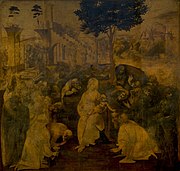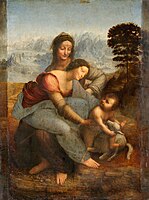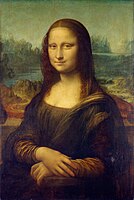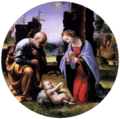Szerkesztő:Cranach~huwiki/próbalap3
Major extant works[szerkesztés]
| Image (sort by size of the original) |
Details (sort by title) |
Attribution status and notes | Dating (sort by earliest) |
|---|---|---|---|
Sablon:Hs
|
| ||
Sablon:Hs
|
|
| |
Sablon:Hs
|
|
| |
Sablon:Hs
|
| ||
Sablon:Hs
|
|
| |
Sablon:Hs
|
Forensic and scientific analysis by M. Seracini now proves that the paint was not applied by da Vinci, but considerably later, so that only the sketch can be "universally accepted" (see M. Henneberger https://www.nytimes.com/2002/04/21/magazine/the-leonardo-cover-up.html. Archives | 2002, The New York Times Magazine, 21 April 2002, "The Leonardo Cover-Up"). Carlo Pedretti, the greatest da Vinci scholar states that the results are unambiguous: "From what he showed me ... it's clear that Leonardo's original sketch was gone over by an anonymous painter." Pedretti adds that he was surprised, though not disappointed, that the news was finally getting out – "it's extremely important and should be said because it has to be clarified." |
| |
Sablon:Hs
|
|
| |
Sablon:Hs
|
|
| |
Sablon:Hs
|
|
| |
Sablon:Hs
|
|
| |
Sablon:Hs
|
|
| |
Sablon:Hs
|
|
| |
Sablon:Hs
|
|
| |
Sablon:Hs
|
|
| |
Sablon:Hs
|
|
||
Sablon:Hs
|
|
| |
Sablon:Hs
|
|
| |
Sablon:Hs
|
|
| |
Sablon:Hs
|
|
| |
Sablon:Hs
|
|
||
| Sablon:Hs |
|
| |
Sablon:Hs
|
|
| |
Sablon:Hs
|
|
| |
Sablon:Hs
|
|
Manuscripts[szerkesztés]
| Sample image | Details | Pages | Notes | Dates |
|---|---|---|---|---|
|
|
1,119 |
|
1478–1519 |
|
|
153 | 1478–1518 | |
|
283 | 1480–1518 | ||
|
55 (originally 62) | Sablon:Circa | ||
|
354 |
|
1487–1505 | |
|
|
more than 2500 |
|
1488–1505 |
|
197 |
|
1490s–1504 | |
|
|
|
Sablon:Circa | |
|
18 |
|
dated 1505 | |
|
72 | 1506–1510 | ||
|
|
Sablon:Circa |
Lost works[szerkesztés]
| Image | Details | Notes | Dating |
|---|---|---|---|
|
|
||
|
|
||
|
|
||
|
|
||
|
|
| |
|
|
||
|
|
Works without consensus on attribution[szerkesztés]
| Image | Details | Attribution Status and Notes | Dating |
|---|---|---|---|
|
|
| |
|
|
| |
|
|||
|
|
||
|
|
||
Sablon:Hs
|
|
| |
|
|
||
|
|
||
|
c. 1495–1500 | ||
|
|
c. 1500 | |
|
|
||
|
|
| |
|
|
||
|
c. 1512 | ||
|
|
|
- ↑ a b c d e f g h i j Forráshivatkozás-hiba: Érvénytelen
<ref>címke; nincs megadva szöveg a(z)Chiesanevű lábjegyzeteknek - ↑ Giorgio Vasari, Lives of the Artists, 1568; this edition Penguin Classics, trans. George Bull 1965, ISBN 0-14-044164-6
- ↑ National Gallery in London accused of altering attribution of Hermitage's 'Leonardo' for 2011 blockbuster show. www.theartnewspaper.com . (Hozzáférés: 2018. augusztus 13.)
- ↑ M. Kemp, entry for The Lady with an Ermine in the exhibition Circa 1492: Art in the Age of Exploration (Washington-New Haven-London) pp 271f, states "the identification of the sitter in this painting as Cecilia Gallerani is reasonably secure;" Janice Shell and Grazioso Sironi, "Cecilia Gallerani: Leonardo's Lady with an Ermine" Artibus et Historiae 13 No. 25 (1992:47–66) discuss the career of this identification since it was first suggested in 1900.
- ↑ a b Marani 2000, p. 339
- ↑ Kemp 2011, 253
- ↑ Syson 2011, 294
- ↑ For a partial list of scholars who accept the attribution, see Leonardo's Saviour of the World rediscovered in New York. The Art Newspaper, 2011. október 31. (Hozzáférés: 2012. február 21.)
- ↑ Syson 2011, 302
- ↑ „Long-lost da Vinci painting fetches $450 million, a world record”, Washington Post, 2017. november 15. (Hozzáférés: 2017. november 16.)
- ↑ Rare Da Vinci painting smashes world records with $450 million sale. CNN , 2017. november 16. (Hozzáférés: 2017. november 16.)
- ↑ „Who Really Painted 'Salvator Mundi'? An Oxford Art Historian Says It Was Leonardo's Assistant | artnet News”, artnet News, 2018. augusztus 7. (Hozzáférés: 2018. augusztus 13.) (amerikai angol nyelvű)
- ↑ The Forster Codices: Leonardo da Vinci's Notebooks at the V&A. Victoria and Albert Museum. (Hozzáférés: 2012. november 4.)
- ↑ Paris Manuscript B. Universal Leonardo. University of the Arts, London. (Hozzáférés: 2012. november 3.)
- ↑ Paris Manuscript C. Universal Leonardo. University of the Arts, London. (Hozzáférés: 2012. november 3.)
- ↑ Paris Manuscript A. Universal Leonardo. University of the Arts, London. (Hozzáférés: 2012. november 3.)
- ↑ Paris Manuscript H. Universal Leonardo. University of the Arts, London. (Hozzáférés: 2012. november 3.)
- ↑ Paris Manuscript M. Universal Leonardo. University of the Arts, London. (Hozzáférés: 2012. november 3.)
- ↑ Paris Manuscript L. Universal Leonardo. University of the Arts, London. (Hozzáférés: 2012. november 3.)
- ↑ Paris Manuscript K. Universal Leonardo. University of the Arts, London. (Hozzáférés: 2012. november 3.)
- ↑ Paris Manuscript I. Universal Leonardo. University of the Arts, London. (Hozzáférés: 2012. november 3.)
- ↑ Paris Manuscript D. Universal Leonardo. University of the Arts, London. (Hozzáférés: 2012. november 3.)
- ↑ Paris Manuscript F. Universal Leonardo. University of the Arts, London. (Hozzáférés: 2012. november 3.)
- ↑ Paris Manuscript E. Universal Leonardo. University of the Arts, London. (Hozzáférés: 2012. november 3.)
- ↑ Paris Manuscript G. Universal Leonardo. University of the Arts, London. (Hozzáférés: 2012. november 3.)
- ↑ Codex Madrid I. Universal Leonardo. University of the Arts, London. (Hozzáférés: 2012. november 3.)
- ↑ Codex Madrid II. Universal Leonardo. University of the Arts, London. (Hozzáférés: 2012. november 3.)
- ↑ Bambach 2003, 723. o.
- ↑ Codex Urbinas and lost Libro A. Universal Leonardo. University of the Arts, London. (Hozzáférés: 2012. április 12.)
- ↑ a b c d e Marani 2000, p. 431
- ↑ Rubin & Wright 1999, pp. 84 and 118, n. 25
- ↑ Shearman 1992, 33. o.
- ↑ Delieuvin 2012, cat. 80
- ↑ Delieuvin 2012, cat. 81
- ↑ St John the Baptist. Art UK. (Hozzáférés: 2013. július 15.)
- ↑ Arasse, Daniel. Leonardo da Vinci. Konecky & Konecky (1997). ISBN 978-1-56852-198-5
- ↑ Kemp, Martin. Leonardo. Oxford: Oxford University Press, 251. o. (2004) The work does not appear in Kemp 2011.
- ↑ Adams, James. „Montreal art expert identifies da Vinci drawing”, The Globe and Mail, 2005. október 13. (Hozzáférés: 2009. október 14.)
- ↑ "The Mark of a Masterpiece" by David Grann, The New Yorker, vol. LXXXVI, no. 20, July 12 & 19, 2010, ISSN 0028-792X
- ↑ Byrne, Paul. „Portrait hailed as Da Vinci masterpiece is actually grumpy Bolton checkout girl”, mirror, 2015. november 30. (Hozzáférés: 2018. augusztus 13.)
- ↑ Pedretti, Carlo. Leonardo da Vinci: the "Virgin of the rocks" in the Cheramy version: its history & critical fortune. Poggio a Caiano: CB edizioni (2017). ISBN 9788897644538
- ↑ Arie, Sophie. „Fingerprint puts Leonardo in the frame”, The Guardian, 2005. február 16. (Hozzáférés: 2007. szeptember 27.)
- ↑ A lost Leonardo? Top art historian says maybe. Universal Leonardo. (Hozzáférés: 2007. szeptember 27.)
- ↑ Bertelli, Carlo. „Due allievi non fanno un Leonardo”, Il Corriere della Sera, 2005. november 19. (Hozzáférés: 2007. szeptember 27.) (italian nyelvű)
- ↑ a b (1993) „The Portrait of Fra Luca Pacioli”. The Mathematical Gazette 77 (479), 140–43, 146–49, 154, 165, 183, 184, 186–87, 197–205, 214. o. DOI:10.2307/3619717.
- ↑ ritratto Pacioli. www.ritrattopacioli.it
- ↑ Livio, Mario. The Golden Ratio: The Story of Phi, the World's Most Astonishing Number, First trade paperback, New York City: Broadway Books, 130–131, 138. o. [2002] (2003). ISBN 0-7679-0816-3
- ↑ Bo, Gianfranco: Il sorriso di Pacioli. utenti.quipo.it
- ↑ a b c Stephane Fitch DaVinci's Fingerprints, 12.22.03 accessed 7 July 2009. Martin Kemp, the expert on Leonardo's fingerprints, had not examined the painting when the article was written.
- ↑ A similar image, without the tormentors, is in the Hermitage Museum, St Petersburg. [1][halott link]
- ↑ „'Early Mona Lisa' painting claim disputed”, BBC News, 2012. szeptember 27. (Hozzáférés: 2013. január 26.)
- ↑ Leonardo Da Vinci: Drawings of Horses and Other Animals from the Royal Library at Windsor Castle. London: Harcourt Brace, 185. o. (1987). ISBN 0384-45284-1 „Fig 111 and 112 Unpublished fragmentary wax model of an equestrian portrait of Charles d'Amboise attributed to Leonardo, said to have come from the Melzi estate at Vaprio d'Adda. London, Private collection (formally Sangiorgi collection in Rome).”
- ↑ „‘Horse and Rider’ Discovered Leonardo Da Vinci Sculpture”, Huffington Post, 2012. augusztus 14. (Hozzáférés: 2014. január 16.)
- ↑ Solari, Ernesto. Leonardo da Vinci Horse and Rider Il "Monumento" a Charles d'Amboise. Milan: Colibri Edizioni, 28. o. (2016). ISBN 978-88-97206-33-0 „Carlo Pedretti: In my opinion, this wax model is by Leonardo himself, and to my knowledge it has not been seen by other scholars.”
- ↑ „Leonardo da Vinci's ‘Horse and Rider’”, BBC News, 2012. augusztus 28. (Hozzáférés: 2014. január 16.)
- ↑ Zerner, Henri (1997. szeptember 25.). „The Vision of Leonardo”. The New York Review of Books 44, 67. o. „no existing sculpture can be attributed to him with any certainty. [... the Bust of Christ as a Youth] was unfortunately placed in the exhibition next to a bizarre object, a wax statuette of a rider on a bucking horse never before seen in public. In the explanatory label, the statuette was said to have belonged to Francesco Melzi, a student and companion of Leonardo, a provenance unfortunately based on hearsay. [...] I fail to see the point of presenting to the uninformed visitor highly debatable hypotheses as if they were confirmed.”
- ↑ Holmstrom, David. „Putting Leonardo's Inventions to the test: Boston's Museum of Science looks at the breathtaking scope of Leonardo da Vinci's work, though the authenticity of some objects is in question”, The Christian Science Monitor, 1997. március 24. „CONTROVERSIAL WORK: Whether Leonardo made this small wax figure is a source of contention among experts. Although the piece is unsigned, it is attributed to him in the exhibit.” Sablon:Subscription
- ↑ Yemma, John. „Leonardo on tour: the good, the bad ... and the phony? Art historians question attribution of some works headed for Boston show”, The Boston Globe, 1997. február 23., A.1. oldal „at least one of the two sculptures on display in the art gallery at Science Park beginning March 3 have caused grave doubts among some art historians. [...] The labels on the paintings, Ackerman warned museum officials, were simply too generous, linking dubious and contested works from private collections too closely with Leonardo and other Italian masters. [...] after weeks of struggling over wording, museum officials altered some of the labels to introduce more skepticism [... The Wax Horse] is "attributed to Leonardo." Not so fast, said Jack Wasserman, an art historian at Temple University in Philadelphia. "There is no single work of sculpture which Leonardo worked on that survived to today," Wasserman said. "Yes, it could be 'attributed to' Leonardo, but you need to have a compelling reason for doing so. Since nothing survived, there is no way to judge a piece of sculpture like this."” Sablon:Subscription
- ↑ Panza, Pierluigi. „La scultura equestre di Leonardo Esposizione tra genio e mistero”, Corriere della Sera, 2016. október 19. (Hozzáférés: 2017. március 1.) (italian nyelvű)
- ↑ Gatti, Chiara. „Arriva l'uomo a cavallo di Leonardo Da Vinci che divide i critici”, la Repubblica, 2016. október 19. (Hozzáférés: 2017. február 22.) (italian nyelvű) „Presentata come una rivelazione esclusiva, è contestata da molti esperti. [...] Vittorio Sgarbi non nasconde i suoi dubbi sull'attribuzione al maestro toscano [...] Pietro Marani: Non ci sono evidenze, né si possono fare confronti poiché non esistono dati d'appoggio, esemplari sicuri.”
- ↑ The Budapest Horse: Beyond the Leonardo da Vinci Question, Making and Moving Sculpture in Early Modern Italy. Routledge, 27. o. (2017. április 25.). ISBN 978-1-351-55951-5
- ↑ Sablon:Cite letter
- ↑ Solari, Ernesto. Leonardo da Vinci : Horse and rider : il "monumento" a Charles d'Amboise, Leonardo, da Vinci, 1452-1519,, Palazzo delle Stelline, Prima edizione (2016). ISBN 9788897206330. OCLC 962823523
- ↑ Self-portrait of Leonardo, Surrentum Online, accessed 2010-11-06
- ↑ Artwork Analysis self Portrait in Red Chalk by Leonardo Da Vinci. Finearts.com . Helium Inc.. [2014. november 29-i dátummal az eredetiből archiválva]. (Hozzáférés: 2014. november 16.)
- ↑ Emergency Treatment for Leonardo da Vinci's Self-Portrait. news.universityproducts.com . Archival Products. (Hozzáférés: 2014. november 16.)
Forráshivatkozás-hiba: <ref> címkék léteznek a(z) „lower-alpha” csoporthoz, de nincs hozzá <references group="lower-alpha"/>




















































